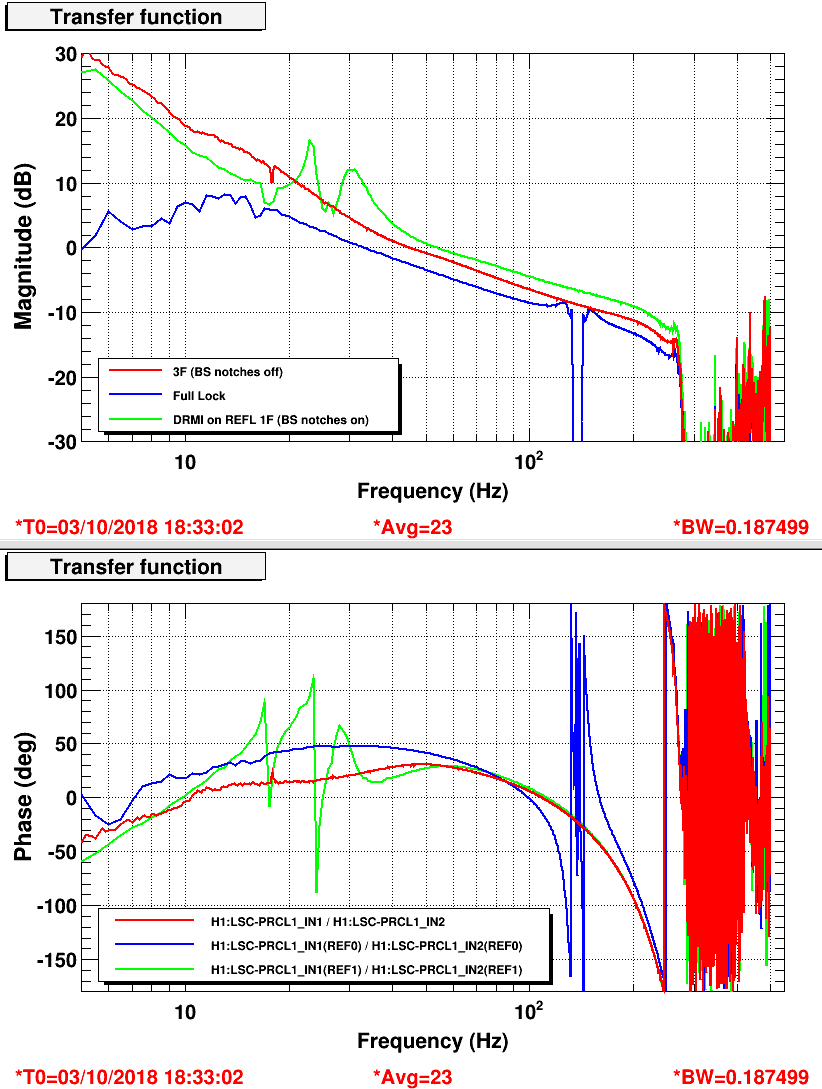[Jenne, Gabriele]
Trying to understand why locking PRMI and DRMI takes much longer, we looked at a few things:
- in PRMI, we checked that the REFL9 and REFL45 demodulation phase are ok.
- in PRMI also the loop shapes and unity gain frequencies are ok
Then we moved to DRMI and found that the demodulation phases for REFL9 and REFL45 were a bit off. So we retuned them(REFL9 from -23 to -20, REFL45 from 97 to 88)
Then we measured the longitudinal loop gains (with DRMI still locked on REFL 1F), and found
- SRCL is ok (there were some wiggles before the phase tuning, due to PRCL cross coupling).
- MICH has higher gain in DRMI than PRMI, but still in the stability margins
- PRCL instead showed some large and weird wiggles at frequencies between 15 and 40 Hz. The structures there are smaller when DRMI is locked on 3F, but still there. They are gone when we switched off the BS bounce and roll notches: with the notches off there are no more weird structures, but the phase still rotates a bit too much. So we have a large cross coupling from MICH to PRCL, that causes a lot of phase rotation and amplitude changes in the PRCL open loop gain when we are on REFL 1F. This surely can't make the lock acquisition any easier.
At the next lock attempt, we should try to switch off the BS notches and see if this makes the lock acquisition easier. We should also improve the REFL 1F sensing matrix to get rid of those cross couplings.
Changed the DRMI REFL 1F sensing element that subtracts PRCL from SRCL from -5.508 to -1.8. This made the SRCL transfer function better.
Also, tuned back REFL45 phase to 96, since this makes the MICH transfer function less coupled to PRCL.
Then I tried adding a MICH to PRCL decoupling to get rid of the BS band stop filter issue. I could get a good transfer function by adding a gain of 4.0 in the REFL45Q to PRCL matrix element. This fixed the PRCL transfer function, but somehow has a large effect on the MICH transfer function: MICH overall gain increased by a factor 2. I don't like this, so I did not implement this element permanently.
My guess is that the real reason we see an effect on the PRCL transfer function due to the BS bandstop filters is that we are currently actuating MICH only on BS, and therefore we are inducing a large driving coupling from MICH to PRCL. We should split the MICH actuation to both BS and PRM, with the right ratio.
However, none of all this seems to have any impact at all on the DRMI lock acquisition times. And the open loop transfer functions look good in full lock, once we are locked on POP signals. So moving on...
More notes about DRMi acquisition, which has been very slow tonight and is preventing us from working on anything else.
- We found that the +106dB filter in SRCL was always on and engaged immediately, which should be ramped over 0.2 or 0.3 seconds. (This is the filter that had the problem described in 44267) We changed it to ramp 0.3 seconds.
- We've had many short DRMI locks where there is a large oscillation in SRCL.
- We added a state to the DRMI guardian to prepare the PRMI to DRMI transition. This is requested at the same time as the suspension is requested to align, and it should turn back on the BS limiter and low pass. We have manually tried lowering the PRCL gain before making the transition, but we still see a 100+ Hz oscillation in MICH when SRM swings in.






